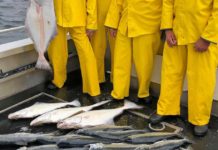Welcome to the latest installment of the Wednesday Wake-Up Call, a roundup of the most pressing conservation issues important to anglers. Working with our friends at Trout Unlimited, Backcountry Hunters & Anglers, the Theodore Roosevelt Conservation Partnership, The Everglades Foundation, Captains for Clean Water, VoteWater.org, Bonefish & Tarpon Trust, and Conservation Hawks (among others), we’ll make sure you’ve got the information you need to understand the issues and form solid opinions.
1. Apache Trout May be De-Listed
The U.S. Fish and Wildlife Service is proposing to remove the native Arizona Apache trout from the List of Endangered and Threatened Species. Collaboration and partner-driven habitat conservation, non-native trout removal, and reintroduction efforts helped save the Apache trout from the brink of extinction. If delisted, it would be the first gamefish to be removed from the list of threatened and endangered species.
“The Apache trout’s recovery is a significant conservation milestone and a remarkable story to celebrate, especially now during the 50th anniversary of the Endangered Species Act,” said Amy Lueders, Fish and Wildlife Service Regional Director. “The ESA makes a difference by bringing people together to find solutions to conserve and recover imperiled species like the Apache trout.”

Photo by Tyler Coleman
Arizona’s state fish, the Apache trout is native exclusively to the streams in and around the White Mountains in the eastern part of the state. It was originally considered the same species as the Gila trout, which was listed under the Endangered Species Preservation Act in 1967. Apache trout was first described as a unique species separate from the Gila trout in 1972. A year later, it gained protection under the Endangered Species Act of 1973 and was subsequently downlisted to threatened in 1975.
A major threat to Apache trout populations has been the introduction of non-native trout. The gene pool was threatened by hybridization with non-native rainbow and cutthroat trout. Additionally, non-native brook and brown trout pose threats through competition and predation. Much of the collaborative conservation work has involved removing these introduced trout from the Apache trout habitat and constructing barriers to block further non-native invasions.
Click here for the full press release at fws.gov
Related stories:
2. U.S. Army Corps leaves door open for large releases as Lake O levels continue to rise
We are in the heart of Florida’s “algae season,” and Lake Okeechobee is uncomfortably high, holding at about 15.3 feet, about 2 feet above normal. If the lake rises to 16.5 feet, the U.S. Army Corps of Engineers will most likely start sending contaminated water down the St. Lucie and Caloosahatchee Rivers to protect the dikes that surround the lake. This could spell disaster for estuaries on both coasts.
“We are going to do our best to avoid them at all possible,” said Maj. Bell. “Using the flexibility afforded to us under LORS2008, we have avoided large releases during the early summer when the algae blooms are at a higher risk. Rather than taking action on a possible situation that may or may not happen in the future, we will continue to be transparent and maintain open communications with our stakeholders.”
Toxic algae is a danger to both wildlife and humans, so avoiding these harmful discharges is in everyone’s best interest. The main goal of Everglades restoration is to make it possible to send that water south, clean it, and then filter it through the natural “River of Grass,” as Nature intended.
Click here to read the full story on fox4now.com
Related stories:
3. The Effects of the Montana Climate Lawsuit Could Change Policy
Back on August 14, a Montana judge sided with a group of young climate activists who had sued the state, arguing that their constitutional rights were being violated by Montana’s support of the oil and gas industries. (Read about it here.) Writing in Newsweek, Todd Tanner–the father of one of the plaintiffs and the man behind the climate-focused NGO Conservation Hawks–discusses what the ruling could mean:
Judge Seeley’s ruling stated that Montana’s greenhouse gas emissions are “nationally and globally significant,” that Montana youth have been harmed by human-caused climate change, and that Montana’s laws promoting fossil fuels are unconstitutional. Montana will now be forced to take climate change into account when it considers permits for new coal mines, power plants, pipelines, and other CO2-producing infrastructure. Barring a stay of her decision from Judge Seeley or Montana’s Supreme Court, the state’s decades-long promotion of fossil fuels will have to stop.

Map via Heat.gov
On a national level, this decision sets an extraordinary new precedent. Climate lawsuits are no longer out on the fringe. Those most at risk from our over-heating planet now have the standing to take legal action, and they can do so with some expectation that they’ll prevail in a court of law.
Click here for the full story in Newsweek
Related stories:
Credit: Source link































